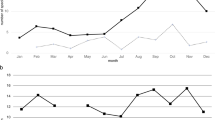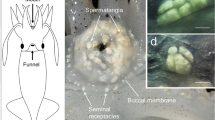Abstract
IT has been shown1 that the male lugworm (Arenicola marina, L.) can be induced to spawn by injecting into the body-cavity the lipid fraction of tissue extracts of whole worms. It was suggested that release of lipid into the body cavity might provide the immediate (internal) stimulus for spawning under natural conditions. The validity of this suggestion can only be tested when the mechanism by which the gametes are emitted is thoroughly understood.
This is a preview of subscription content, access via your institution
Access options
Subscribe to this journal
Receive 51 print issues and online access
$199.00 per year
only $3.90 per issue
Buy this article
- Purchase on Springer Link
- Instant access to full article PDF
Prices may be subject to local taxes which are calculated during checkout
Similar content being viewed by others
References
Howie, D. I. D., J. Mar. Biol. Assoc. U.K., 41, 127 (1961).
Newell, G. E., J. Mar. Biol. Assoc. U.K., 27, 554 (1948).
Howie, D. I. D., J. Mar. Biol. Assoc., U.K., 41, 771 (1961).
Author information
Authors and Affiliations
Rights and permissions
About this article
Cite this article
HOWIE, D. Spawning Mechanism in the Male Lugworm. Nature 192, 1100–1101 (1961). https://doi.org/10.1038/1921100a0
Issue Date:
DOI: https://doi.org/10.1038/1921100a0
This article is cited by
-
An ultrastructural study of spermatogenesis and sperm morula breakdown inArenicola marina (L.) (Annelida: Polychaeta)
Helgoländer Meeresuntersuchungen (1992)
Comments
By submitting a comment you agree to abide by our Terms and Community Guidelines. If you find something abusive or that does not comply with our terms or guidelines please flag it as inappropriate.



